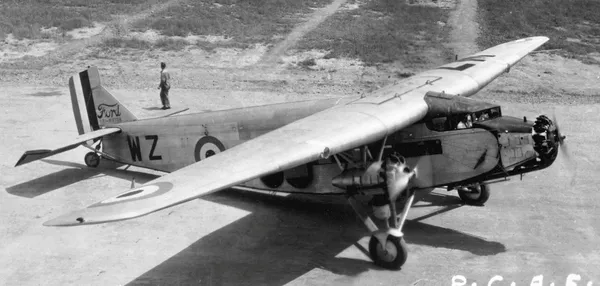Trimotor (Total: 1, Canadian: 1, Group 0)
Ford-Stout Trimotor

Ford Model 4-AT Trimotor [name revised], RCAF, Reg. No. G-CYWZ, St. Hubert, Quebec, June 1931
The Ford Trimotor (also called the "Tri-Motor", and nicknamed the "Tin Goose") is an American three-engined transport aircraft. Production started in 1925 by the companies of Henry Ford and ended on June 7, 1933. A total of 199 Ford Trimotors were made. It was designed for the civil aviation market, but also saw service with military units.
The Ford Trimotor was a development of previous designs by William Bushnell Stout, using structural principles copied from the work of Professor Hugo Junkers, the noted German all-metal aircraft design pioneer, and adapted to an airframe very similar to the Fokker F.VII - even using the same airfoil cross section at the wing root. In 1925, Ford bought Stout and its aircraft designs.
The Ford Trimotor using all-metal construction was not a revolutionary concept, but it was certainly more advanced than the standard construction techniques of the 1920s. The aircraft resembled the Fokker F.VII Trimotor (except for being all-metal which Henry Ford claimed made it "the safest airliner around"). Its fuselage and wings followed a design pioneered by Junkers during World War I with the Junkers J.I and used postwar in a series of airliners starting with the Junkers F.13 low-wing monoplane of 1920 of which a number were exported to the US, the Junkers K 16 high-wing airliner of 1921, and the Junkers G 24 trimotor of 1924. All of these were constructed of aluminum alloy, which was corrugated for added stiffness, although the resulting drag reduced its overall performance.
Although designed primarily for passenger use, the Trimotor could be easily adapted for hauling cargo, since its seats in the fuselage could be removed. To increase cargo capacity, one unusual feature was the provision of "drop-down" cargo holds below the lower inner wing sections of the 5-AT version.
The original (commercial production) 4-AT had three air-cooled Wright radial engines. It carried a crew of three: a pilot, a copilot, and a stewardess, as well as eight or nine passengers. The later 5-AT had more powerful Pratt & Whitney engines. All models had an aluminum corrugated sheet-metal body and wings. Unlike many aircraft of this era, extending through World War II, its control surfaces (ailerons, elevators, and rudders) were not fabric-covered, but were also made of corrugated metal. As was common for the time, its rudder and elevators were actuated by metal cables that were strung along the external surface of the aircraft. Engine gauges were also mounted externally, on the engines, to be read by the pilot while looking through the aircraft windshield. Wikipedia
Trimotor 4-AT serial G-CYWZ
s/n GCYWZ
m/d 6-ATS-Special
c/n 6-ATS-1
G-CYWZ
Known Units:
Originally purchased for crop dusting experiments. First tests spraying hemlock forests near Westree, Ontario in June of 1929, carrying 1,600 pounds of powdered insecticide. Similar tests in Quebec later that year. Allegedly looped by Squadron Leader R.S. Grandy during these trials. Later based at Rockcliffe, Ontario, and used as VIP transport, carrying VIPs from Ottawa to St. Hubert to view and ride on R100 during its visit to Canada in 1930. It was also the support transport for the RCAF aerobatics team the "Siskins" during the 1931 Air Pageant. Appeared at air show at RCAF Station Trenton in June 1934. Trials with Lear radio compass, September to November 1935. Operated by Test Flight at Rockcliffe, pilots included Squadron Leader Tudhope on 8 November. Operated on skis, date unknown. Sold to United Air Transport as CF-BEP, registered to them on 24 March 1937. Destroyed in ground collision with RCAF Hurricane 321 in 1939. Stored as spares for CF-BYN, scrapped in 1941.last update: 2025-November-19
1937-February-25 to Civil Register Canadian Sold to civil register. 2019-08-20
1937-February-25 Struck off Strength 2020-09-19